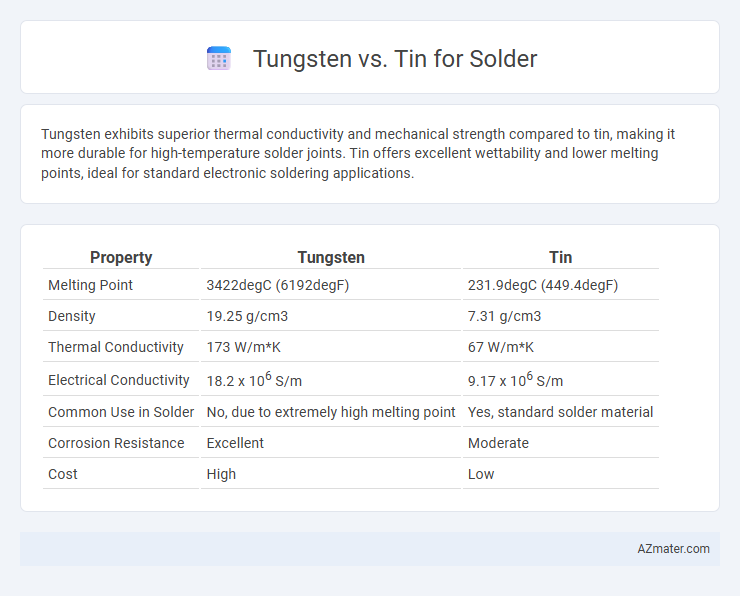Tungsten exhibits superior thermal conductivity and mechanical strength compared to tin, making it more durable for high-temperature solder joints. Tin offers excellent wettability and lower melting points, ideal for standard electronic soldering applications.
Table of Comparison
| Property | Tungsten | Tin |
|---|---|---|
| Melting Point | 3422degC (6192degF) | 231.9degC (449.4degF) |
| Density | 19.25 g/cm3 | 7.31 g/cm3 |
| Thermal Conductivity | 173 W/m*K | 67 W/m*K |
| Electrical Conductivity | 18.2 x 106 S/m | 9.17 x 106 S/m |
| Common Use in Solder | No, due to extremely high melting point | Yes, standard solder material |
| Corrosion Resistance | Excellent | Moderate |
| Cost | High | Low |
Introduction to Soldering Materials
Tungsten and tin serve distinct roles in soldering materials, with tin commonly used as the primary alloy in solder due to its low melting point and excellent wetting properties. Tungsten, with its high melting point and superior hardness, is rarely an alloy component but is important in soldering tools and electrodes for precision applications. Choosing the appropriate solder material depends on the required electrical conductivity, thermal stability, and mechanical performance in the specific soldering application.
What is Tungsten?
Tungsten is a dense, hard metal with the highest melting point among all pure metals, reaching 3422degC (6192degF), making it highly resistant to heat and wear in soldering applications. Unlike tin, which melts around 232degC (450degF) and is commonly used as a solder alloy, tungsten's exceptional thermal stability limits its direct use in solder but makes it valuable in high-temperature environments or as a reinforcement material. Its properties of high tensile strength, corrosion resistance, and low thermal expansion differentiate tungsten from tin, influencing their distinct roles in electronics and metallurgical processes.
What is Tin?
Tin is a silvery-white metal commonly used as the primary component in solder due to its excellent melting point and strong adhesion properties. It offers good corrosion resistance and flexibility, making it ideal for creating reliable electrical connections in electronics. Tungsten, in contrast, is rarely used in solder because its high melting point and hardness limit its application in joining metals.
Physical and Chemical Properties Comparison
Tungsten exhibits a high melting point of 3422degC and exceptional hardness, making it resistant to deformation and corrosion, while tin melts at a much lower temperature of 232degC, enabling easy melting for soldering applications. Chemically, tungsten is inert and stable under high-temperature oxidizing conditions, contrasting with tin's susceptibility to oxidation and its ability to form intermetallic compounds with other metals in solder alloys. These distinct physical and chemical properties determine tungsten's impracticality as a solder material compared to tin's widespread use in electronics for its excellent wetting and bonding capabilities.
Melting Points: Tungsten vs Tin
Tungsten has a melting point of approximately 3422degC (6192degF), which is significantly higher than tin's melting point of 232degC (450degF). This vast difference makes tin ideal for soldering applications requiring low-temperature melting to prevent component damage, while tungsten's high melting point limits its use as a solder material but makes it suitable for high-temperature environments and electrode applications. Understanding these melting point disparities is crucial for selecting the appropriate material in electronics manufacturing and metal joining processes.
Electrical Conductivity Differences
Tungsten offers significantly lower electrical conductivity compared to tin, with tungsten's conductivity around 17% of the International Annealed Copper Standard (IACS) versus tin's approximately 15%. This disparity impacts solder performance, as tin-based solders facilitate better electrical flow and signal integrity in electronic connections. Consequently, tin remains the preferred choice in solder alloys for maximizing electrical conductivity, while tungsten may be used in niche applications requiring higher thermal resistance or mechanical strength.
Durability and Strength Analysis
Tungsten offers superior durability and strength compared to tin in solder applications due to its high melting point and exceptional hardness, making it ideal for high-stress or high-temperature environments. Tin solder, while easier to work with due to its lower melting point and good wettability, lacks the mechanical robustness of tungsten-based alloys, resulting in reduced resistance to mechanical fatigue and thermal cycling. The combination of tungsten's tensile strength and resistance to wear enhances the longevity of solder joints, particularly in industrial and electronics applications requiring maximal reliability.
Common Applications in Soldering
Tungsten is rarely used in soldering due to its extremely high melting point of 3422degC, making it impractical for typical solder joint applications. Tin, often alloyed with lead or silver, is the primary metal in solder because of its low melting point around 232degC and excellent wettability on copper, making it ideal for electronics, plumbing, and metalwork soldering. Common solder alloys like Sn63Pb37 or SAC305 (Sn-Ag-Cu) rely heavily on tin for reliable, efficient electrical and mechanical connections in circuit boards and metal assemblies.
Cost and Availability
Tungsten is significantly more expensive than tin due to its rarity and complex extraction process, making it less cost-effective for solder applications. Tin, being widely available and abundant, offers a lower-cost option ideal for mass production in electronics soldering. The accessibility of tin ensures steady supply chains, whereas tungsten's limited availability and high demand in other industries restrict its use in solder manufacturing.
Environmental and Health Considerations
Tungsten, a heavy metal with low toxicity, poses minimal environmental and health risks compared to tin, which is commonly used in traditional lead-free solder alloys. Tin mining and processing can generate hazardous waste and increase the risk of tin poisoning, affecting aquatic ecosystems and human health through bioaccumulation. Tungsten's high melting point and chemical stability reduce environmental contamination during soldering processes, making it a more sustainable choice for eco-friendly electronic manufacturing.

Infographic: Tungsten vs Tin for Solder
 azmater.com
azmater.com